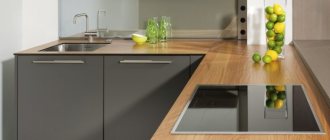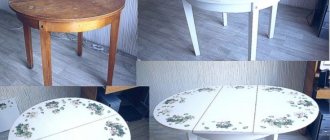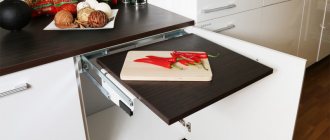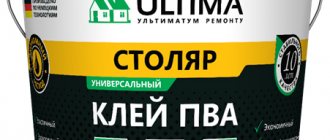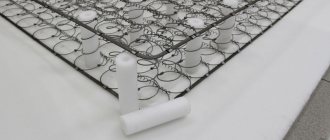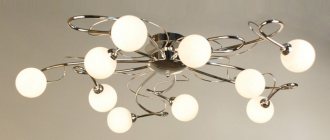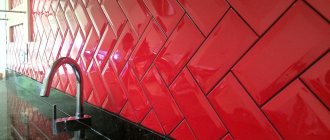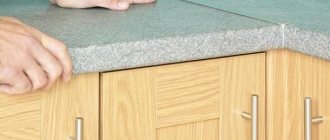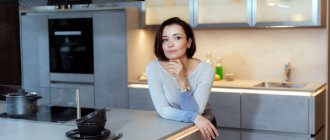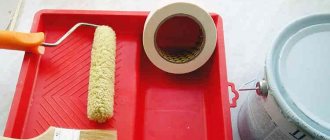Advantages and disadvantages of the material
Pros of epoxy resin:
- The top board of the table, filled with epoxy, is not susceptible to any damage, and it looks very impressive, especially if decoupage technique or a similar one is used.
- Dried material does not shrink.
- When the surface hardens, it becomes as smooth as possible, like glass.
The table is filled with epoxy resin and is resistant to external damage.
A countertop with epoxy filling is not susceptible to either aggressive cleaning agents or moisture.
Cons of epoxy:
- To perform high-quality filling, it is necessary to strictly observe the proportions of the components.
- A sharp decrease in t leads to the appearance of white “flakes” in the fill, its deepest layers.
NOTE! Eliminating the last drawback will not be difficult. Warming the table top to +60 will help get rid of white flakes.
When pouring resin on a table, you need to carefully follow all steps for an effective result.
Manufacturers rating
Before purchasing, it is advisable to familiarize yourself with the brands of different manufacturers and the pricing policies of these companies. To decide which resin to use to fill the countertop, we offer a list of the most popular and in demand compounds:
QTP-1130
A universal brand specialized for pouring countertops. A good choice for inexperienced craftsmen. The recommended maximum layer thickness is 3 mm. This is an ideal option for a countertop decorated with slab or large stone.
This brand is also chosen for filling decoupage, which involves pictures and photographs. The mixture is transparent and does not have a yellowish tint after hardening. Low viscosity promotes self-leveling of the surface and thorough filling of voids. Scope of application: small desks and coffee tables.
Art-Eco
The brand belongs to research and production. The company positions itself not only as a manufacturer, but also as a developer of epoxy resins for household use, as well as numerous accessories for them. Colors, pigment pastes, solvents to reduce viscosity, separators and other necessary materials are presented in a wide range
. The recommended maximum thickness of the filling layer is 5-7 mm. The quality of the materials from this company is high, but careful adherence to proportions is required when mixing the resin with the hardener. A barely noticeable yellowish tint is possible after removal, so the compositions of this brand are often tinted.
ED-20
The advantage of this brand is that it is produced in accordance with GOST. The downside is that it is a somewhat outdated modification that does not quite meet modern requirements. The resin is characterized by high viscosity, which causes numerous bubbles to appear when mixed with the hardener. Over time, the transparency of the polymer decreases and a yellowish tint appears.
Some modifications of ED-20 have increased strength and are successfully used for pouring floors. Professionals consider the low cost of this resin to be a significant advantage. It is recommended for beginners.
CHS Epoxy 520
The resin from a Czech manufacturer is sold complete with hardener 921 OP. A quality product with an excellent reputation in the market. Epoxy is suitable for the most difficult jobs, for example, pouring a herbarium.
It copes well with any small decor, wood, metal. An important quality is the absence of boiling even when filling large volumes.
Crystal Glass
Product of Russian production (city of Yaroslavl). It has high fluidity and is well suited for filling large areas. According to the instructions, after mixing with the hardener that comes with the kit, the resin should infuse for some time. This increases viscosity.
Professionals prefer to work with this epoxy. It is possible to use Crystal Glass in jewelry making.
PEO-610KE
Certified according to GOST, the letter E in the name stands for “elasticity”. An important indicator for a tabletop, since elasticity allows you to distribute the load under mechanical stress. Life time is about four hours, complete hardening occurs after two to three days.
The epoxy is average in price, the hardener is universal and is suitable for all resins of this brand.
EpoxAcast 690
Russian production, . The compound from expensive varieties is primarily positioned as a resin for jewelry.
For countertops it is used when it is necessary to fill a layer up to 5 cm. Solid and durable epoxy, in large volumes it can shrink slightly.
MG-EPOX-STRONG
Epoxy resin made in Germany. A product with an impeccable reputation, high quality and recommended by many professionals.
In the technical specifications it is listed as a super-strong and super-transparent compound. The complete hardening time is about three days.
Epoxy CR 100
Modern, universal, extremely safe epoxy resin. The rating of its technical characteristics is very high, the brand is distinguished by chemical resistance, wear resistance, and antistatic properties. Professionals often recommend choosing this particular brand.
Magic Crystal-3D
Durable, wear-resistant epoxy that is not afraid of exposure to direct sunlight. Most often used for making jewelry and 3D flooring. Well suited for filling glossy coatings.
Varieties
Epoxy countertops come in the following variations:
- Made from boards with resin filling as a protective layer. The basis of the surface can be the following material: fibreboards, solid wood, OSB, etc. Often the filling of this part of the kitchen unit is preceded by decoration (stencil painting, decoupage, print, shells, mosaic, etc. - whatever suits your taste ).
- Made entirely of epoxy, no support. This type is often found when making surfaces for which significant loads are not planned: coffee tables or coffee tables.
- Combined - in this case, the filler material alternates with elements of another, usually wood.
Tabletop with a combination of epoxy resin and wood.
Types of epoxy tables
The variety of models allows you to choose a table to suit every taste, and each product has its own characteristics. Most often, natural materials are used, the presence of which makes the furniture unique.
Epoxy resin table with lighting
Glowing table models equipped with LED strip have a magical effect. Instead of diodes, some craftsmen prefer to use phosphor. The substance is mixed in a ratio of 1 to 3 (a spoonful of phosphor to three spoonfuls of epoxy resin), then the composition is poured into the recesses of a wooden tabletop. You can also cover the entire surface with resin, or connect slabs of wood with a transparent composition. At night, the luminescent glow gives the interior a magical mood.
The photo shows a table with epoxy resin lighting. A solution with a phosphor fills cracks, turning an uneven tabletop into a bright, exclusive piece of furniture.
Epoxy resin and stone table
The basis is a slab or slab of natural stone. Such a massive product looks expensive and impressive, but has a high cost and weight. The stone base gives the tabletop stability, so the tables are heavy and low. Polishing the surface allows you to reveal all the beauty of the product: picturesque differences in the rock, its texture and pattern.
The photo shows a low table made of stone. Epoxy resin poured in a wave pattern gives the cold stone a soft, sophisticated look.
Epoxy resin wood coffee table
Wood has many advantages and is an ideal solution for the production of furniture with epoxy resin. It is a malleable material that can be shaped into any shape. Wooden blanks are durable, light in weight, and easy to work with. But most importantly, the raw edges of the cuts can be easily filled with liquid resin, creating picturesque patterns.
If epoxy resin countertops do not have a wooden base, then the structures will not withstand high loads. Only small decorative tables are produced this way.
The photo shows a round coffee table made of epoxy resin and wood on a metal support.
Epoxy resin river table
The basis of the structure is two wood boards, between which the solution is poured. The most commonly used are oak, ash, and elm. The frozen composition repeats the unevenness of the slab, imitating a river and two banks. The resemblance to water is achieved not only due to the shape, but also the transparency of the composition, to which blue dye is often added.
Recently, the river table has become very popular, and for good reason: the glossy surface looks mesmerizing, and the cuts reveal the texture of natural wood. The table can be placed in the kitchen, living room or office. A luxurious product will decorate any environment and fit harmoniously into loft, art deco, fusion and eco-style.
The photo shows a rectangular table made of slab and epoxy mixture with the addition of green dye.
Table made of sawn wood and epoxy resin
The frame of the structure can be made not only of boards, but also of sawn wood. Typically, workpieces have cracks, irregularities and even through holes. Thanks to the poured and cured resin, these disadvantages turn into advantages, giving the product a unique design. For a small table, a wide cut 6-8 cm thick is suitable: curly edges will give the structure a special shape, and the transparent composition will add elegance to the product.
Small cuts from logs or stumps are also used as decoration: oval and round parts of various sizes are laid out on the base and filled with a liquid composition.
The photo shows a wood cut from a hollow log, which was given a second life by creating a magnificent coffee table.
Epoxy table with decorative filling
Using resin, new furniture is created and old furniture is restored. All kinds of elements of the plant world are used as decoration for inserts: moss, flowers, leaves, cones.
Epoxy, which looks like frozen water, is an ideal material for maintaining a marine theme: shells, pebbles, and artificial seaweed are suitable fillers. Hand-painted masterpieces deserve special attention. To create a three-dimensional image, the resin is poured in stages, and paint is applied between layers.
The photo shows an unusual table, which consists of laminated chipboard and an insert with an imitation of the seabed.
An even more interesting option for table design is the use of photographs. To decorate an old tabletop, you need to clean it of dirt and sand it, then distribute the pictures over the surface. You can take personal photos and create a collage, or print ready-made images. The photographs must be secured with glue, and the table must have temporary sides (formwork). You should start pouring the resin from the center to the edges, distributing it evenly with a spatula.
The photo shows a decorated tabletop made of epoxy resin with a painting in the shape of a fish.
With added dye to resin
Often, when making tables from epoxy resin, professionals use special coloring agents: color helps to give the product a special character, make it more memorable and emphasize the author’s idea. The white surface made of hardened resin, similar in color to milk, looks original and allows the table to fit into any interior. Black dye gives the product austerity and makes it even more respectable. Furniture with multi-colored patterns becomes the highlight of the home, and the unique pattern provides it with exclusivity.
The photo shows a table painted with multi-colored colors using a special technology using a hairdryer.
Criterias of choice
The resin for pouring the table top must be transparent and also have a sufficient life expectancy, otherwise there is a risk of seeing with your own eyes how the resin “boils” or spending a very long time pouring in layers.
Resins, which are called base ones, are not at all suitable in this situation, since they are thicker: air bubbles will not be able to escape. Also, base resins are more fragile and are not always colorless. Moreover, the hardeners used with such resins will not produce a long-term mixture. This threatens both boiling of the mixture and deformation of the table during rapid hardening.
Base resins are not very suitable for pouring a table.
Epoxy Resin Selection
Epoxy is chosen based on what problems you need to solve. That is, do you need elasticity of the product or a convex lens, etc.
The material must:
- harden slowly;
- have low viscosity;
- be transparent;
- do not lose volume when pouring.
When choosing a resin, pay attention to the transparency of the material.
Calculate the amount of resin required to make a table cover
To do this, it is worth remembering the volume formula and multiplying the desired length and width of the table by the thickness of the fill. For example: 210*15*4 (respectively) = 12600 cm3 or 12.6 kg of filling material. It is worth considering: the density of the resin is greater than the density of water K = 1.1. Therefore, the final calculation result will look like this: 12600 * 1.1 = 13860 kg of resin.
Filling the countertop
IMPORTANT! Carefully read the instructions for the purchased resin set!!! This will help avoid possible unpleasant surprises during the work.
Before you start pouring the table, you need to prepare all the necessary elements.
Prepare the form or assemble the formwork. Make sure the frame/mold is sealed. Because even through the smallest crack, the entire future surface of the table can leak. The cracks are sealed with a special sealant, paraffin, thermal glue, or possibly plasticine.
Now the frame/mold should be treated with a release agent. Then we level it!
Requirements
It should be noted right away that you won’t be able to save on material. Those resin modifications that are low cost are unlikely to be suitable for creativity, since they do not meet the requirements presented below. Among the technical parameters, the minimum layer thickness is of practical importance. No craftsman needs instant hardening of the resin. After pouring, the compound should have time to fill all the cavities, and air bubbles should come to the surface.
In addition, if there is decor, you may need to make some adjustments to its placement. If you take resin in a volume less than recommended, it will begin to set very quickly, which will negatively affect the quality of the product. As a rule, the first layer of resin is used to fix the decor at the base of the tabletop.
The most important parameter is the maximum layer thickness, which varies from 1.5 mm to 6 cm, and in rare cases more.
Many beginners prefer to choose brands of resins that allow them to fill the countertop in one go, but there is a certain nuance here.
- Firstly, layer-by-layer filling allows you to create three-dimensional images when decorating each layer.
- Secondly, the large volume of resin that has to be poured at one time can cause intense heat generation during curing.
Useful to know > What primer is made based on epoxy resin and where it is used
If the master decides to opt for a resin with a maximum layer thickness of 5-6 cm, then preference should be given to those models that have a long lifetime, because it guarantees a low reaction rate of the interaction of the components.
Typically, final curing takes about a day. However, you need to read the instructions to clarify this parameter. The fact is that the next layer can be poured only after the previous layer has completely cured. The remaining selection criteria are related to the cost and popularity of the manufacturer. If the cost is very easy to determine, then the rating of manufacturers and suppliers will have to be studied additionally. It is useful to take advantage of the advice and tips of experienced craftsmen. We will give several examples of popular brands that, in all their parameters, meet the requirements for filling countertops.
Step-by-step instruction
If it is necessary to tint the resin, then the introduction of the hardener into the resin should precede the addition of the dye.
Stir thoroughly until smooth. To make the pigment disperse faster, the resin is heated to 40 C (in a water bath or placed near a radiator).
Mix the components, following all the instructions. Mix along the edges of the walls and in the middle.
IMPORTANT! If the mixture turns out to be inhomogeneous, it will ruin your product!
Now a thin layer of resin is poured onto the bottom of the mold and decorative elements are laid out.
Pour the prepared mixture into the mold. It can be poured at once if the thickness of what is being poured is no more than 5 cm.
Pouring a wooden tabletop with epoxy resin.
If a table surface with a thickness of 6 cm or more is cast, the pouring is done in two layers, in 2 stages. It should take one to two days for one layer to harden.
ATTENTION! The resin is poured into one point in a thin stream. You can pour along an inclined stick lowered into the mold.
Peculiarities
The store will likely stock a number of two-component compounds consisting of a base material and a hardener. In this form, epoxy is most suitable for work. Before mixing, the components remain in liquid form for an indefinitely long time, which means that the master can begin preparing the composition and pouring it when it is convenient for him, without time restrictions.
During the polymerization process, the compound retains its volume without shrinking. The transparency of the resin does not change when exposed to ultraviolet radiation, so the countertops retain their aesthetic appearance throughout their entire service life. The fluidity of the resin allows you to decorate the tabletop slab in a variety of ways. Despite the strength of the material, the resin can melt when exposed to high temperatures. Surfaces cannot be polished or ground using an angle grinder.
The cost of epoxy resin is difficult to estimate objectively. For one kilogram of compound you will have to pay from 700 to 1500 rubles, depending on the brand and manufacturer.
If we compare the cost of production with the cost of the finished product, the material turns out to be relatively inexpensive. Alternative options exist, however, in order for them to have similar strength, waterproofing, and durability, additional processing will have to be carried out, which will entail an increase in costs.
Epoxy resin performs several functions at the same time. In addition to creating a transparent surface, it serves as a material to stabilize the wood. The compound not only covers the wood from above, but also penetrates into the smallest pores. By the way, if photographs, natural materials, or plant flowers are used as decoration, then under a layer of epoxy they remain in their original form for a long time. Some designers see shading as a way to preserve family photos.
The potential of resin in artistic creation should also be appreciated. By varying the color, the master can create an imitation of bodies of water, the starry sky, and flora. Ideas of an abstract nature are also interesting. By adding a phosphor to the composition, luminous elements are obtained. In addition, the dielectric properties of epoxy make it possible to install electrical circuits for lighting. LED strips are usually used as a light source.
Useful to know > Anles epoxy adhesive, created on the basis of an old development, and its varieties
Popular types of resin grades
When deciding which epoxy resin to choose for pouring the countertop, we suggest paying attention to the following brands:
"Art-Eco"
Most suitable for thin layers, especially when sufficient hardener is added. Among other things, this brand implies excellent colors that allow you to give any shade to the material.
Epoxy resin Art-eco.
QTP-1130
Suitable for making a transparent cover of a coffee table or desk, if the filling layer is no more than 3 mm. This epoxy is especially transparent and can level itself.
Crystal Glass
Transparent resin, its distinctive feature is fluidity. This is an ideal option when creating small layers, as well as when working with various fillers (grass, wood fragments, coins, etc.).
"ED-20"
The resin is characterized by low viscosity and demonstrates the maximum combination of advantages; it is very common and in demand. It has an acceptable cost.
CHS Epoxy 520
Suitable for activities with complex fillers, it is the best and most popular material for making the top board for the table. Therefore, if this important part of the kitchen set will be placed where the sun falls, you should pay attention to this option when making a countertop.
N3 -PEO-610KE
Over time, it does not turn yellow at all under the influence of heat and direct rays of the sun.
Epoxy resin table in interior design.
Advantages and disadvantages
An epoxy table can be purchased from craftsmen, made to order, or created independently. A description of its features will help you learn more about furniture made of epoxy resin, but ultimately the determining factor for most people is its aesthetic qualities and exclusivity.
| Advantages | Flaws |
| A table with the addition of resin is not afraid of mechanical damage and is not scratched by dishes. | High price of the starting material. |
| It is resistant to moisture and easy to clean: the smooth surface can simply be wiped with a wet cloth. | During manufacturing, it is necessary to strictly follow the instructions, since even the slightest deviation can lead to defects in the product. |
| Does not fade in the sun. | Epoxy resin is not resistant to low temperatures; in the cold the material delaminates. |
| The material does not shrink after pouring. | When heated, it releases toxic substances (however, in a residential area, the harmfulness of epoxy is minimal, since the air in the apartment does not heat up to dangerous temperatures). |
| It is easy to decorate, has an aesthetic appearance and makes it possible to realize any design ideas. | Do not place hot pots and pans on a table with epoxy resin, otherwise the material will melt. |
